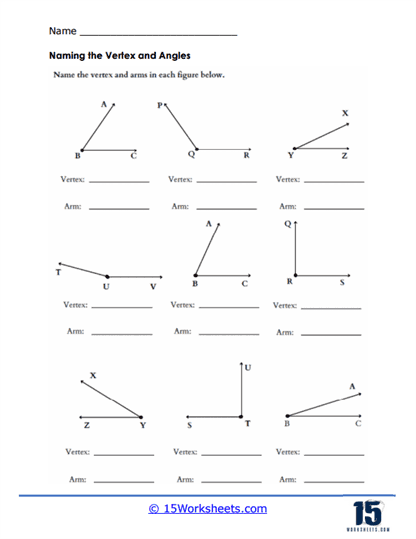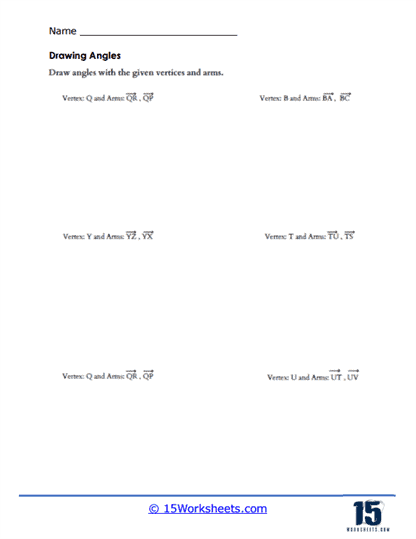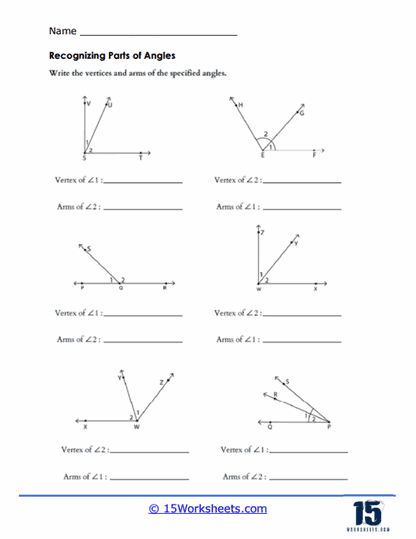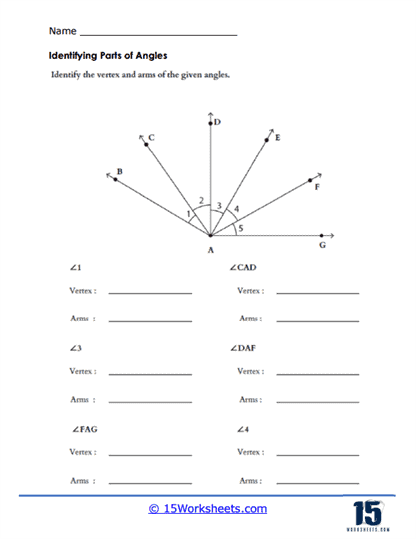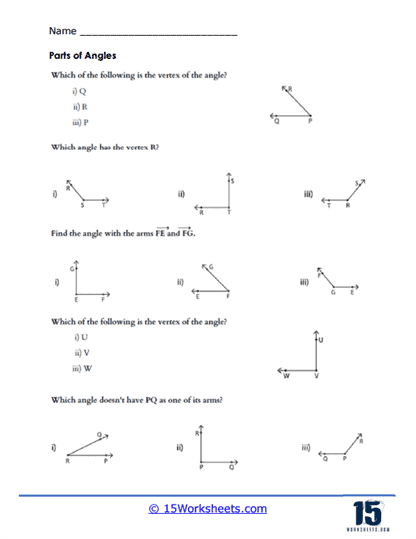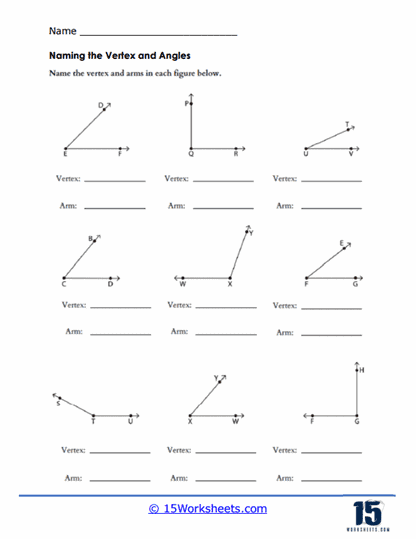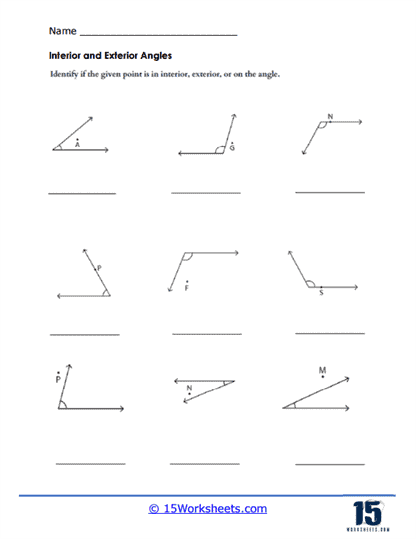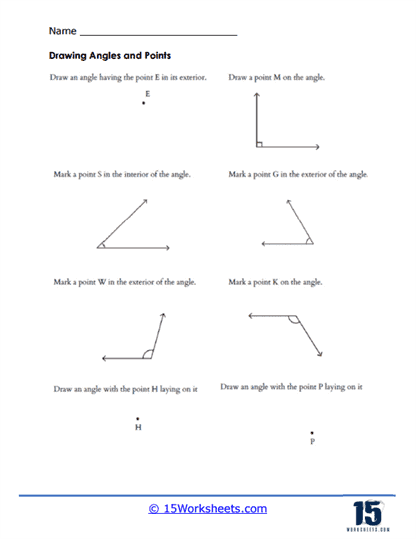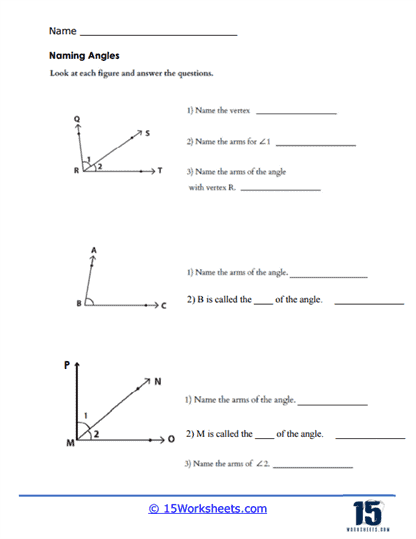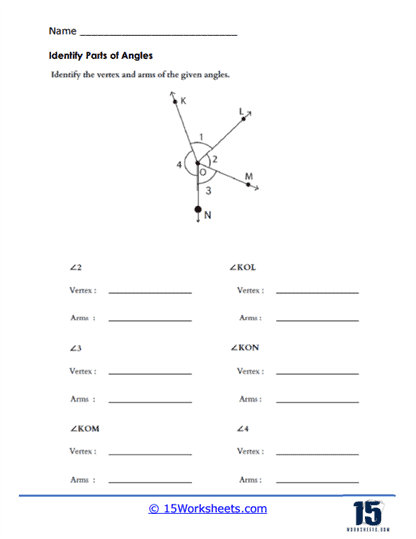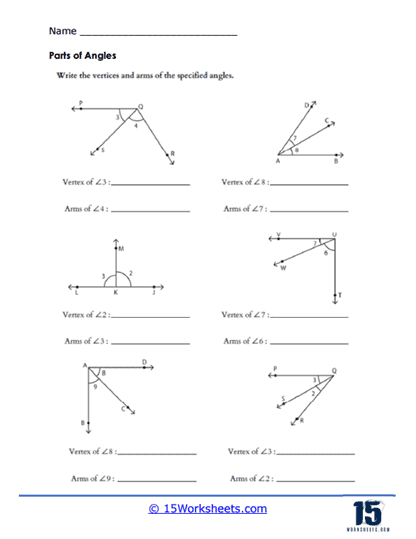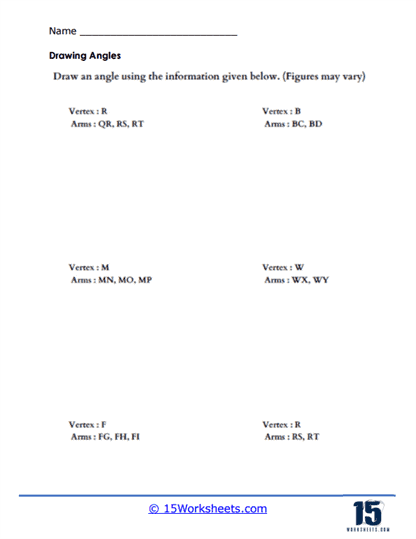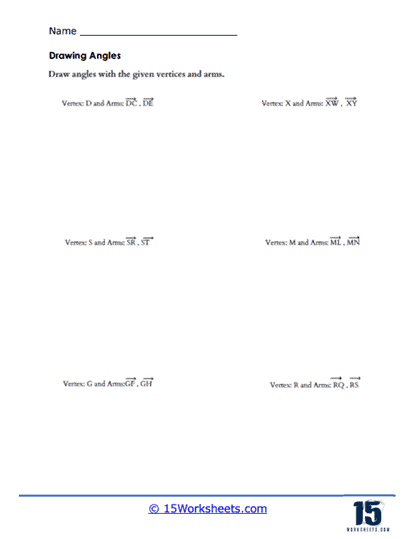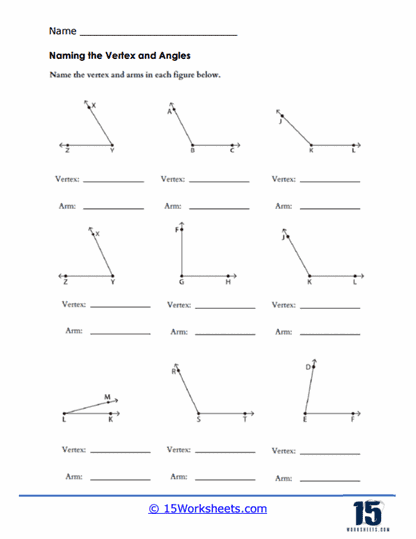Parts of an Angle Worksheets
About These 15 Worksheets
These worksheets will help students grasp fundamental concepts related to angles, including degrees, radians, and their applications. These worksheets serve as a foundation for understanding geometric principles and developing mathematical reasoning skills. They typically cover a range of exercises that progressively challenge students to apply their knowledge in various contexts, fostering a deeper understanding of angles and their significance in real-world scenarios.
One of the primary math skills explored in parts of an angle worksheets is the ability to measure and classify angles using degrees. Students learn to identify angles as acute (less than 90 degrees), obtuse (more than 90 degrees but less than 180 degrees), right (exactly 90 degrees), and straight (exactly 180 degrees). Through practice problems, they refine their ability to estimate and accurately measure angles using protractors or by recognizing common angle measurements.
Another crucial skill emphasized in these worksheets is understanding the concept of a full circle, which comprises 360 degrees. Students explore how angles relate to circles and learn to calculate unknown angles within circles using basic geometric principles. They practice converting angle measures between degrees and radians, reinforcing their understanding of angular measurement systems used in different mathematical and scientific contexts.
Parts of an angle worksheets also delve into the geometric properties and relationships involving angles. Students explore complementary and supplementary angles, where complementary angles add up to 90 degrees and supplementary angles add up to 180 degrees. By solving problems involving these angle relationships, students reinforce their understanding of how angles interact and complement each other geometrically.
These worksheets often include exercises that challenge students to apply their angle measurement skills in problem-solving contexts. For instance, students may be presented with scenarios involving architectural designs, where they need to calculate angles to ensure structural integrity or aesthetic balance. In engineering contexts, they might analyze angles to optimize the design and functionality of mechanical components.
These worksheets frequently incorporate activities that require students to construct and manipulate angles. They practice drawing angles of specified measurements using rulers and protractors, developing proficiency in geometric construction techniques. These exercises encourage precision and accuracy in angle representation, essential skills for visualizing and communicating geometric concepts effectively.
Parts of an angle worksheets often include real-world applications that highlight the practical significance of angle measurement. Students encounter problems related to navigation and orientation, where understanding angles helps determine directions or coordinates. They may also explore applications in fields such as astronomy, where angles play a crucial role in celestial navigation and observations.
Types of exercises found on parts of an angle worksheets vary in complexity to accommodate different levels of student proficiency. Beginners might start with simple exercises involving identifying and measuring basic angles, gradually progressing to more challenging problems that involve calculating angles in complex geometric figures or applying angle properties in problem-solving scenarios. Intermediate and advanced exercises may focus on trigonometric concepts, such as sine, cosine, and tangent functions, which relate angle measures to side lengths in right-angled triangles.
These worksheets often integrate interactive and hands-on activities to engage students actively in the learning process. These may include online simulations where students manipulate virtual protractors to measure angles or interactive tutorials that provide immediate feedback on angle-related exercises. Such resources enhance student engagement and facilitate self-paced learning, allowing students to reinforce their understanding of angles through interactive practice.
Real World Applications
Parts of an angle, such as degrees and radians, play crucial roles in various real-world applications that students encounter daily. Understanding these components equips students with essential skills for interpreting and manipulating spatial information. In fields like architecture and engineering, angles determine the orientation and alignment of structures. Architects use angles to design buildings, ensuring proper support and aesthetic appeal. Engineers apply angles in designing bridges and roads, ensuring structural integrity and safety. Moreover, in navigation and geography, understanding angles helps in determining directions and coordinates using tools like compasses and GPS systems. Pilots and sailors rely on angles to chart courses accurately across vast distances.
Beyond technical fields, angles are integral in sports and games. Athletes and coaches analyze angles to optimize strategies in sports like soccer, basketball, and billiards. A soccer player calculates the best angle to shoot for a goal, while a billiards player assesses angles to make precise shots. In everyday tasks, angles influence how we perceive and interact with our environment. Artists use angles to create perspective and depth in paintings, while photographers adjust angles to capture compelling images. Even in household tasks like hanging pictures or assembling furniture, understanding angles ensures items are level and secure.
Educationally, learning about angles develops critical thinking and problem-solving skills. Students practice spatial reasoning when they measure, compare, and manipulate angles in geometry problems. They learn to visualize shapes and structures in three dimensions, enhancing their ability to understand and interpret diagrams and blueprints. Moreover, mastery of angles fosters a deeper appreciation for the mathematical principles underlying everyday phenomena, empowering students to make informed decisions in various contexts.
Parts of an angle are not just abstract concepts confined to textbooks but practical tools that shape how we interact with and understand the world around us. By grasping the significance of angles, students not only excel academically but also gain skills that are directly applicable to numerous aspects of their daily lives and future careers.

